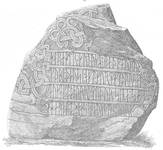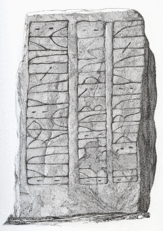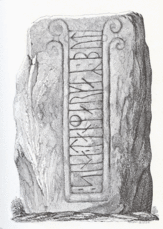- Gorm, Thyra and Harald
- The rune stones
- Gorm the Old’s rune stone
- Harald Bluetooth’s rune stone
- Basse’s rune stone
- How are rune stones read?
- The rune stones past and present
- Henrik Rantzau’s view, 1591
- Jon Skonvig, 1627
- Søren Abildgaard, 1771
- Ole Jørgen Rawert, 1819
- Adam Müller, 1835
- Jakob Kornerup, 1861
- Julius Magnus-Petersen, 1869-71
- Julius Magnus-Petersen, 1878
- Hans Andersen Kjær, 1897
- Photographs by a member of the public, 1935
- Runologist Erik Moltke, 1971
- Ludvig Stubbe-Teglbjærg’s rubbings, 1973
- Peter Henrichsen, moulding and copying in 1984
- Roberto Fortuna, 2006
- The conservation investigation 2006-08
- 3D light scanning, 2007
- Harald Bluetooth’s rune stone at home and abroad
- Pictures from Jelling
Julius Magnus-Petersen, 1869-71
As a young man Julius Magnus-Petersen (1827-1917) stood and drew rune stones in his spare time in the spiral ramp of the Round Tower in Copenhagen. Here were placed various rune stones brought to Copenhagen by antiquary Ole Worm in 1652. The stones later became a part of the Antiquities Commission’s collections in the loft of the Trinity Church. As Magnus-Petersen stood and drew, Professor Peder Goth Thorsen (1811-1883), who was interested in runes, was passing and noted the illustrator’s abilities. This chance meeting was the start of a collaboration in publication of the Danish rune stones. Magnus-Petersen drew the Jutlandic rune stones over three summers in the years 1869-71 and in one of these summers he visited Jelling. Thorsen’s work ’Jutland’s Runic Monuments with Additional Reports on all the Islands’ was published in 1879.
Magnus-Petersen drew the broken-off area in the second and third lines on the front side of Gorm’s small rune stone with almost the same extent as it has today. The missing area visible today in the first line in kurmR is not shown. On the other hand Magnus-Petersen has marked a long crack right through the word. There is also a long crack in the second line, which can be seen today as a long sequence of cracks on both sides of the broken-off area. On the back side the finishing at the top of the rune band is interpreted as spirals and lines. Magnus-Petersen has thus been on the way to interpreting the motif as a snake’s head.
Magnus-Petersen has drawn the broken-off area and the large crack system across the top of the text side of Harald’s large rune stone in the same way as Jakob Kornerup did in 1861. However, the damage has grown slightly in extent. On the other hand in his drawing of the animal side Magnus-Petersen has not marked the crack running downwards from the triangular broken-off piece to the same extent as Kornerup. The large broken-off piece towards the bottom is also reproduced in a diffuse way and most of the cracks, which are visible today in the twisted rope to the left and at the bottom, are also shown. On the Christ side he has not drawn any damage on the upper half of the stone, but apart from that the missing areas and cracks are the same as those drawn by Adam Müller in 1835 and Kornerup in 1861.




